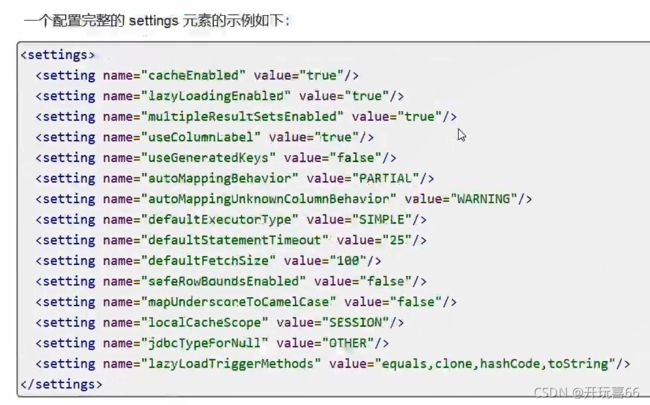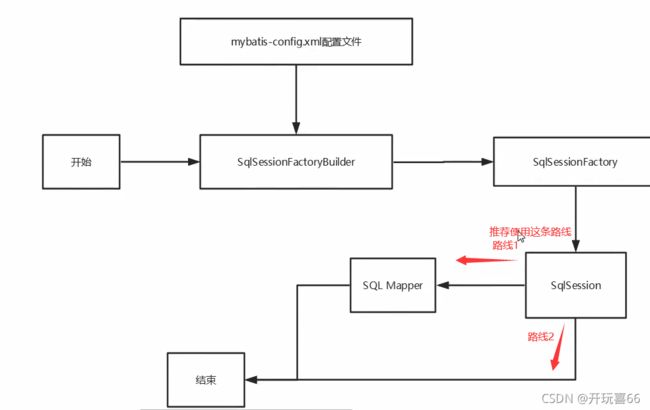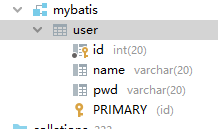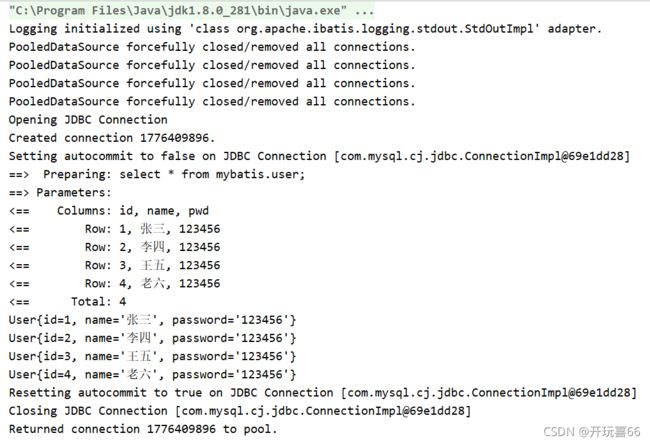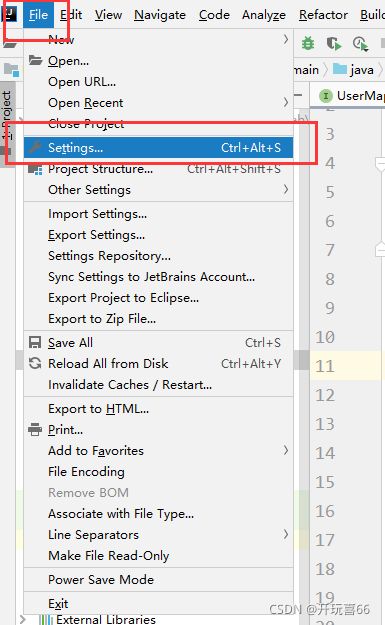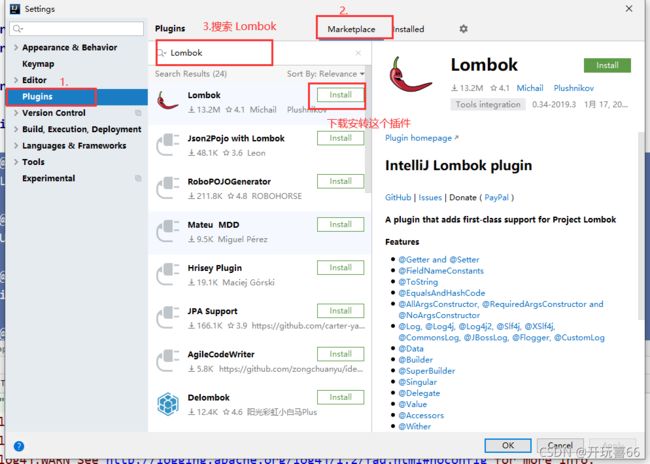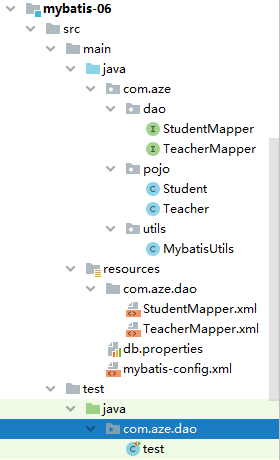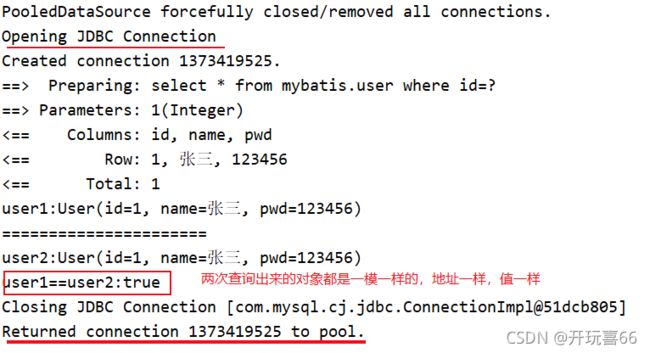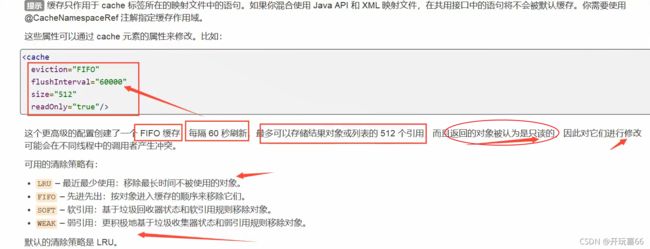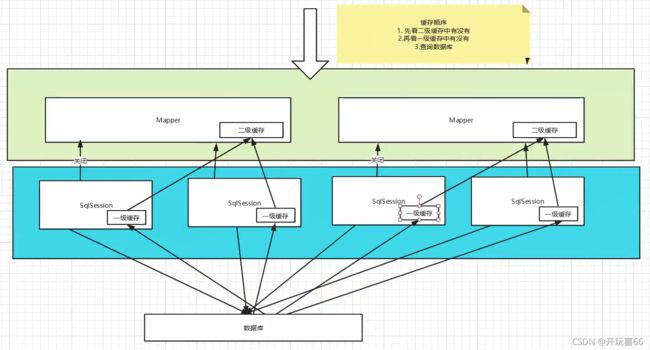SSM-MyBatis
MyBatis
https://mybatis.org/mybatis-3/zh/index.html
文章目录
- MyBatis
-
- 1、简介
-
- 1.1 什么是 MyBatis
- 1.2 MyBatis 发展
- 1.3 如何获取 MyBatis
- 1.4 持久化
- 1.5 持久层
- 1.6 为什么使用 MyBatis
- 1.7 MyBatis 特点
- 2、我的第一个 MyBatis 程序
-
- 2.1 搭建环境
- 2.2 创建一个不同模块
- 2.3 编写代码
- 2.4 测试
- 2.5 测试中遇到的问题
- 3、CRUD(增删改查)
-
- 3.1 namespace
- 3.2 select
- 3.3 insert
- 3.4 update
- 3.5 delete
- 3.6Map
- 3.7 模糊查询
- 4、配置解析
-
- 4.1 核心配置文件
- 4.2 环境配置(environments)
- 4.3 属性(properties)
- 4.4 类型别名(typeAliases)
- 4.5 设置(settings)
- 4.6 其他配置
- 4.7 映射器(mappers)
- 4.8 作用域(Scope)和生命周期
- 5、解决属性名和字段名不一致的问题
-
- 5.1 问题
- 5.2 解决办法
-
- 5.2.1 给服务器字段起别名
- 5.2.2 resultMap(结果集映射)
- 6、日志
-
- 6.1 日志工厂
- 6.2 Log4j
- 7、分页
-
- 7.1 使用 Limit 分页
- 7.2 使用 MyBatis 实现分页,核心 sql
- 7.3 RowBounds 分页
- 7.4 分页插件
- 8、使用注解开发
-
- 8.1 面向接口编程
-
- 8.1.1 接口的理解
- 8.1.2 三个面向区别
- 8.2 注解开发
- 8.3 CRUD(增删改查)
- 8.4 关于 @Param() 注解
- 8.5 #{} 和 ${} 的区别
- 9、MyBatis 的详细执行流程
- 10、Lombok
-
- 10.1 使用步骤
- 10.2 优缺点
- 11、多对一处理
-
- 11.1 SQL :
- 11.2 测试环境搭建
- 11.3 按照查询嵌套处理
- 11.4 按照结果嵌套处理
- 12、一对多
-
- 12.1 按结果嵌套处理
- 12.2 按查询嵌套处理
- 13、多对一、一对多 小结
- 14、动态 SQL
-
- 14.1 什么是动态 SQL?
- 14.2 搭建环境
- 14.3 IF
- 14.4 choose(when、otherwise)
- 14.5 trim(where、set)
- 14.6 SQL 片段
- 14.7 foreach
- 15、缓存
-
- 15.1 MyBatis 缓存
- 15.2 一级缓存
- 15.3 缓存失效情况
- 15.4 二级缓存
- 15.5 缓存原理
- 15.6 自定义缓存 ehcache
1、简介
1.1 什么是 MyBatis
- MyBatis 是一款优秀的持久层框架
- 它支持自定义 SQL、存储过程以及高级映射
- MyBatis 免除了几乎所有的 JDBC 代码以及设置参数和获取结果集的工作
- MyBatis 可以通过简单的 XML 或注解来配置和映射原始类型、接口和 Java POJO(Plain Old Java Objects,普通老式 Java 对象)为数据库中的记录。
1.2 MyBatis 发展
- MyBatis 本是 apache 的一个开源项目开源项目 iBatis
- 2010年这个项目由 apache software foundation 迁移到了google code,并且改名为 MyBatis
- 2013年11月迁移到 Github
1.3 如何获取 MyBatis
-
Maven 仓库:https://mvnrepository.com/search?q=mybatis
<dependency> <groupId>org.mybatisgroupId> <artifactId>mybatisartifactId> <version>3.5.7version> dependency> -
Github:https://github.com/mybatis/mybatis-3
-
中文文档:https://mybatis.org/mybatis-3/zh/index.html
1.4 持久化
数据持久化:
- 持久化就是将程序的数据在持久状态和瞬时状态的转化过程
- 持久状态:数据库(jdbc)、IO 文件
- 瞬时状态:内存
- 内存:断电即失
为什么需要持久化?
- 不能失去一些对象
- 内存不适合没钱人!
1.5 持久层
- 完成持久化工作的代码块
- 层界限非常明显
1.6 为什么使用 MyBatis
- 更方便将数据存入数据库中
- 用的人多
- 传统的 JDBC 代码太复杂。
- 简化,更容易上手
- 框架
- 自动化
1.7 MyBatis 特点
- 简单易学:本身就很小且简单。没有任何第三方依赖,最简单安装只要两个 jar 文件以及配置几个 sql 映射文件易于学习,易于使用,通过文档和源代码,可以比较完全的掌握它的设计思路和实现。
- 灵活:mybatis 不会对应用程序或者数据库的现有设计强加任何影响。sql 写在 xml 里,便于统一管理和优化。通过 sql 语句可以满足操作数据库的所有需求。
- 解除 sql 与程序代码的耦合:通过提供 DAO层,将业务逻辑和数据访问逻辑分离,使系统的设计更清晰,更易维护,更易单元测试。sql 和代码的分离,提高了可维护性。
- 提供映射标签,支持对象与数据库的 orm 字段关系映射
- 提供对象关系映射标签,支持对象关系组建维护
- 提供xml标签,支持编写动态sql。
2、我的第一个 MyBatis 程序
MyBatis 程序思路:
- 搭建环境 —> 导入 jar 包 —> 编写代码 —> 测试
2.1 搭建环境
搭建一个数据库
CREATE DATABASE `mybatis`;
USE `mybatis`;
CREATE TABLE `user`(
`id` INT(20) NOT NULL,
`name` VARCHAR(20) DEFAULT NULL,
`pwd` VARCHAR(20) DEFAULT NULL,
PRIMARY KEY (`id`)
)ENGINE=INNODB DEFAULT CHARSET=utf8;
INSERT INTO `user`(`id`,`name`,`pwd`)
VALUE (1,'张三','123456'),
(2,'李四','123456'),
(3,'王五','123456')
新建一个项目
-
新建一个普通的 maven 项目
-
核对 maven 配置
-
删除 src (这是一个父工程,干净最好)
-
导入依赖包
- mysql 驱动
- mybatis
- 单元测试 junit
<dependencies> <dependency> <groupId>mysqlgroupId> <artifactId>mysql-connector-javaartifactId> <version>8.0.25version> dependency> <dependency> <groupId>org.mybatisgroupId> <artifactId>mybatisartifactId> <version>3.5.7version> dependency> <dependency> <groupId>junitgroupId> <artifactId>junitartifactId> <version>4.13version> dependency> dependencies>
2.2 创建一个不同模块
编写 mybatis 的核心配置文件(mybatis-config.xml)
DOCTYPE configuration
PUBLIC "-//mybatis.org//DTD Config 3.0//EN"
"http://mybatis.org/dtd/mybatis-3-config.dtd">
<configuration>
<environments default="development">
<environment id="development">
<transactionManager type="JDBC"/>
<dataSource type="POOLED">
<property name="driver" value="com.mysql.jdbc.Driver"/>
<property name="url" value="jdbc:mysql://localhost:3306/mybatis?useSSL=true&useUnicode=true&characterEncoding=UTF-8"/>
<property name="username" value="root"/>
<property name="password" value="root"/>
dataSource>
environment>
environments>
configuration>
编写 mybatis 工具类(MybatisUtils)
// SqlSessionFactory ---> SqlSession
public class MybatisUtils {
private static SqlSessionFactory sqlSessionFactory;
static {
// 获取 sqlSessionFactory 对象
try {
String resource = "org/mybatis/example/mybatis-config.xml";
InputStream inputStream = Resources.getResourceAsStream(resource);
sqlSessionFactory = new SqlSessionFactoryBuilder().build(inputStream);
} catch (IOException e) {
e.printStackTrace();
}
}
// 既然有了 SqlSessionFactory,顾名思义,我们可以从中获得 SqlSession 的实例
// SqlSession 提供了在数据库执行 SQL 命令所需的所有方法
// 你可以通过 SqlSession 实例来直接执行已映射的 SQL 语句。
public static SqlSession getSqlSession(){
return sqlSessionFactory.openSession();
}
}
2.3 编写代码
-
实体类
package com.aze.pojo; public class User { private int id; private String name; private String pwd; public User() { } public User(int id, String name, String pwd) { this.id = id; this.name = name; this.pwd = pwd; } public int getId() { return id; } public void setId(int id) { this.id = id; } public String getName() { return name; } public void setName(String name) { this.name = name; } public String getPwd() { return pwd; } public void setPwd(String pwd) { this.pwd = pwd; } @Override public String toString() { return "User{" + "id=" + id + ", name='" + name + '\'' + ", pwd='" + pwd + '\'' + '}'; } } -
Dao 接口(Mapper 接口)
package com.aze.dao; import com.aze.pojo.User; import java.util.List; public interface UserMapper { // 查询所用用户的所有信息 List<User> getUserList(); } -
接口实现类(UserMapper.xml)
- JavaWeb 中是编写 UserDaoImpl.java 来实现
- 如今使用 UserMapper.xml 来实现(简洁方便)
DOCTYPE mapper PUBLIC "-//mybatis.org//DTD Mapper 3.0//EN" "http://mybatis.org/dtd/mybatis-3-mapper.dtd"> <mapper namespace="com.aze.dao.UserMapper"> <select id="getUserList" resultType="com.aze.pojo.User"> select * from mybatis.user; select> mapper>
2.4 测试
- 单元测试 junit
package dao;
import com.aze.dao.UserMapper;
import com.aze.pojo.User;
import com.aze.utils.MybatisUtils;
import org.apache.ibatis.session.SqlSession;
import org.junit.Test;
import java.util.List;
public class UserMapperTest {
@Test
public void test1(){
// 1. 获得 sqlSession 对象
SqlSession sqlSession = MybatisUtils.getSqlSession();
// 2. 获取 UserMapper 接口中的方法
// 方式一
// 方式一方法有很多优势,首先它不依赖于字符串字面值,会更安全一点
// 其次,如果你的 IDE 有代码补全功能,那么代码补全可以帮你快速选择到映射好的 SQL 语句
UserMapper mapper = sqlSession.getMapper(UserMapper.class);
List<User> userList = mapper.getUserList();
// 方式二
// 这种方式和用全限定名调用 Java 对象的方法类似
// 这样,该命名就可以直接映射到在命名空间中同名的映射器类,并将已映射的 select 语句匹配到对应名称、参数和返回类型的方法
//List userList1 = sqlSession.selectList("com.aze.dao.UserMapper.getUserList");
// 遍历查询结果
for (User user : userList) {
System.out.println(user);
}
// 3. 关闭 sqlSession
sqlSession.close();
}
}
2.5 测试中遇到的问题
-
编写的 Mapper.xml 配置文件没有注册(很多人都会忘记的事!)
- 解决办法:在 mybatis-config.xml 中注册 配置文件
<mappers> <mapper resource="com/aze/dao/UsetMapper.xml"/> mappers> -
文件过滤,在 java 文件夹下的 xml 文件是会被过滤的(Maven 导出资源问题)
- 解决办法:在父工程的 pom.xml 中配置文件过滤的 build 即可
<build> <resources> <resource> <directory>src/main/resourcesdirectory> <includes> <include>**/*.propertiesinclude> <include>**/*.xmlinclude> includes> <filtering>truefiltering> resource> <resource> <directory>src/main/javadirectory> <includes> <include>**/*.propertiesinclude> <include>**/*.xmlinclude> includes> <filtering>falsefiltering> resource> resources> build> -
java.io.IOException: Could not find resource org/mybatis/example/mybatis-config.xml
- 问题所在:在 mybatis 工具类,获取 sqlSessionFactory 对象的 配置文件路径写错了
- 解决:修改为正确路径
-
Loading class ‘com.mysql.jdbc.Driver’. This is deprecated. The new driver class is `com.mysql.cj.jdbc.Driver’. The driver is automatically registered via the SPI and manual loading of the driver class is generally unnecessary.
- 问题所在:com.mysql.jdbc.Driver 数据库驱动已经被弃用了
- 解决:将 com.mysql.jdbc.Driver 改为 com.mysql.cj.jdbc.Driver
-
Cause: java.sql.SQLSyntaxErrorException: Unknown database ‘mybatis/’
- 问题所在:mybatis-config.xml 配置文件中,url 的地址写错了

- 解决办法:将上图的斜杠去掉(/)
-
以上是本人遇到的,可能还有其他的,给我上网查!!!
-
还有可能遇到的问题:
- 判定接口错误
- 方法名不对
- 返回类型不对
3、CRUD(增删改查)
3.1 namespace
namespace 中的 包名 要和 Dao/mapper 接口的包名一致
- select
- id:namespace 中对应的方法名
- resultType:sql 语句执行的返回值
- parameterType:参数类型
- insert
- update
- delete
注意:增删改 需要提交事务,否则数据库中的数据不会改变!!!
注意:增删改 需要提交事务,否则数据库中的数据不会改变!!!
注意:增删改 需要提交事务,否则数据库中的数据不会改变!!!
3.2 select
选择,查询语句:
-
编写Mapper接口方法(UserMapper.java)
// 查询所用用户的所有信息 List<User> getUserList(); // 根据 id 查询用户 User getUserById(int id); -
编写 Mapper接口方法的配置文件(UserMapper.xml)
<mapper namespace="com.aze.dao.UserMapper"> <select id="getUserList" resultType="com.aze.pojo.User"> select * from mybatis.user; select> <select id="getUserById" resultType="com.aze.pojo.User" parameterType="int"> select * from mybatis.user where id=#{id} select> mapper> -
编写测试方法
// 获取所有用户所有信息 @Test public void test1(){ // 1. 获得 sqlSession 对象 SqlSession sqlSession = MybatisUtils.getSqlSession(); // 2. 获取 UserMapper 接口中的方法 // 方式一 // 方式一方法有很多优势,首先它不依赖于字符串字面值,会更安全一点 // 其次,如果你的 IDE 有代码补全功能,那么代码补全可以帮你快速选择到映射好的 SQL 语句 UserMapper mapper = sqlSession.getMapper(UserMapper.class); List<User> userList = mapper.getUserList(); // 方式二 // 这种方式和用全限定名调用 Java 对象的方法类似 // 这样,该命名就可以直接映射到在命名空间中同名的映射器类,并将已映射的 select 语句匹配到对应名称、参数和返回类型的方法 //ListuserList1 = sqlSession.selectList("com.aze.dao.UserMapper.getUserList"); // 遍历查询结果 for (User user : userList) { System.out.println(user); } // 3. 关闭 sqlSession sqlSession.close(); } // 根据 id 查询用户 @Test public void test2(){ // 1. 获取 SqlSession 对象 SqlSession sqlSession = MybatisUtils.getSqlSession(); // 2. 获取 UserMapper 接口中的方法 UserMapper mapper = sqlSession.getMapper(UserMapper.class); User userById = mapper.getUserById(2); System.out.println(userById); // 3.关闭 sqlSession sqlSession.close(); } -
测试
3.3 insert
增添语句:
-
编写Mapper接口方法(UserMapper.java)
// 新增一个用户 int addUser(User user); -
编写 Mapper接口方法的配置文件(UserMapper.xml)
<insert id="addUser" parameterType="com.aze.pojo.User"> insert into mybatis.user(id, name, pwd) value (#{id},#{name},#{pwd}) insert> -
编写测试方法
// 新增一个用户,增删改必须要提交事务 @Test public void addTest(){ SqlSession sqlSession = MybatisUtils.getSqlSession(); UserMapper mapper = sqlSession.getMapper(UserMapper.class); int i = mapper.addUser(new User(4,"老六","123456")); if (i > 0){ System.out.println("成功!"); } // 提交事务(增删改都必须要有) sqlSession.commit(); sqlSession.close(); } -
测试
3.4 update
修改语句:
-
编写Mapper接口方法(UserMapper.java)
// 修改一个用户 int updateUser(User user); -
编写 Mapper接口方法的配置文件(UserMapper.xml)
<update id="updateUser" parameterType="com.aze.pojo.User"> update mybatis.user set name=#{name},pwd=#{pwd} where id=#{id} update> -
编写测试方法
// 修改用户信息 @Test public void updateUserTest(){ SqlSession sqlSession = MybatisUtils.getSqlSession(); UserMapper mapper = sqlSession.getMapper(UserMapper.class); int i = mapper.updateUser(new User(4, "火箭", "666666")); if (i > 0){ System.out.println("修改成功!"); } sqlSession.commit(); sqlSession.close(); } -
测试
3.5 delete
删除语句:
-
编写Mapper接口方法(UserMapper.java)
// 根据 id 删除用户 int deleteUserById(int id); -
编写 Mapper接口方法的配置文件(UserMapper.xml)
<delete id="deleteUserById" parameterType="int"> delete from mybatis.user where id=#{id} delete> -
编写测试方法
// 根据 id 删除用户 @Test public void deleteUserByIdTest(){ SqlSession sqlSession = MybatisUtils.getSqlSession(); UserMapper mapper = sqlSession.getMapper(UserMapper.class); int i = mapper.deleteUserById(4); if (i > 0){ System.out.println("删除成功!"); } sqlSession.commit(); sqlSession.close(); } -
测试
3.6Map
如果实体类或者数据库中的表,字段或者参数很多,我们就可以使用 Map
- Map 传递参数,直接在 sql 取出 key (parameterType=“Map”)
- 对象传递参数,直接在 sql 中取出对象的属性(parameterType=“Object”)
- 只有一个基本类型参数的情况下,可以直接在 sql 中取得
- 多个参数使用 Map 或者 注解
// 使用 map 新增用户
int addUserByMap(Map<String,Object> map);
<insert id="addUserByMap" parameterType="Map">
insert into mybatis.user(id, name, pwd) value (#{id4},#{name4},#{password4})
insert>
// 使用 Map 新增用户
@Test
public void addUserByMapTest(){
SqlSession sqlSession = MybatisUtils.getSqlSession();
UserMapper mapper = sqlSession.getMapper(UserMapper.class);
Map<String, Object> map = new HashMap<String, Object>();
map.put("id4",4);
map.put("name4","老六");
map.put("password4","123456");
int i = mapper.addUserByMap(map);
if (i > 0){
System.out.println("新增成功!");
}
sqlSession.commit();
sqlSession.close();
}
3.7 模糊查询
-
java 代码执行的时候,传递通配符 %
List<User> userList = mapper.getUserLike("%李%"); -
在 sql 拼接中使用通配符
select * from mybatis.user where name like "%"#{value}"%"
4、配置解析
4.1 核心配置文件
mybatis-config.xml
- MyBatis 的配置文件包含了会深深影响 MyBatis 行为的设置和属性信息。 配置文档的顶层结构如下:
- configuration(配置)
- properties(属性)
- settings(设置)
- typeAliases(类型别名)
- typeHandlers(类型处理器)
- objectFactory(对象工厂)
- plugins(插件)
- environments(环境配置)
- environment(环境变量)
- transactionManager(事务管理器)
- dataSource(数据源)
- environment(环境变量)
- databaseIdProvider(数据库厂商标识)
- mappers(映射器)
- configuration(配置)
4.2 环境配置(environments)
MyBatis 可以配置成适应多种环境
- 尽管可以配置多个环境,但每个 SqlSessionFactory 实例只能选择一种环境
- 要学会配置多套 运行环境
MyBatis 默认的事务管理器是 JDBC,默认连接池 POOLED
4.3 属性(properties)
通过 properties 属性来实现引用配置文件
这些属性可以在外部进行配置,并可以进行动态替换。你既可以在典型的 Java 属性文件中配置这些属性,也可以在 properties 元素的子元素中设置。(db.properties)
编写一个配置文件:
db.properties
driver=com.mysql.cj.jdbc.Driver
url=jdbc:mysql://localhost:3306/mybatis?useSSL=true&useUnicode=true&characterEncoding=UTF-8
username=root
password=root
在核心配置文件中引入
- 可以直接引入外部文件
<properties resource="db.properties"/>
- 可以在这里增加一些属性配置
<properties resource="db.properties">
<property name="键" value="值">
properties>
- 如果两个文件有同一个字段,优先会使用外部配置文件
4.4 类型别名(typeAliases)
类型别名是为 Java 类型设置一个短的名字
存在的意义仅用于减少类完全限定名的冗余
- 可以给实体类起别名:
<typeAliases>
<typeAlias type="com.aze.pojo.User" alias="User"/>
typeAliases>
- 也可以指定一个包名,MyBatis 会在包名下搜索需要的 JavaBean:
- 扫描实体类的包,它的默认别名就为这个类首字母小写的类名
<typeAliases>
<package name="com.aze.pojo"/>
typeAliases>
-
区别:
-
第一种起别名的方法,在实体类比较少的情况下使用
-
第二种方法,在实体类非常多的时候使用
-
第一种起的别名可以DIY(自定义)
-
第二种起的别名在核心配置文件中不能够自定义,只能在注解中修改
@Alias("user") public class User{}
-
4.5 设置(settings)
这是 MyBatis 中纪委重要的调整设置,他们会改变 MyBatis 的运行时行为
4.6 其他配置
- typeHandlers(类型处理器)
- objectFactory(对象工厂)
- plugins(插件)
- mybatis-generator-core
- mybatis-plus
- 通用 mapper
4.7 映射器(mappers)
MapperRegistry:注册绑定我们的 Mapper 文件
每一个 Mapper.xml 都需要在 MyBatis 核心配置文件中注册!
-
方式一:使用相对于类路径的资源引用(推荐使用这个)
<mappers> <mapper resource="com/aze/dao/UserMapper.xml"/> mappers> -
方式二:使用映射器接口实现类的完全限定类名
- 注意:
- 接口和它的 Mapper 配置文件必须同名
- 接口和它的 Mapper 配置文件必须在同一个包下
<mappers> <mapper class="com.aze.dao.UserMapper"/> mappers> - 注意:
-
方式三:将包内的映射器接口实现全部注册为映射器
- 注意
- 接口和它的 Mapper 配置文件必须同名
- 接口和它的 Mapper 配置文件必须在同一个包下
<mappers> <mapper name="com.aze.dao"/> mappers> - 注意
4.8 作用域(Scope)和生命周期
作用域和生命周期是至关重要的,因为错误的使用会导致非常严重的并发问题。
SqlSessionFactoryBuilder:
- 一旦创建了 SqlSessionFactory,就不需要它了
- 局部变量
SqlSessionFactory:
- 可以比作为:数据库连接池
- SqlSessionFactory 一旦被创建就应该在应用的运行期间一致存在,没有任何理由抛弃他或重新创建另一个实例
- SqlSessionFactory 的最佳作用域是应用作用域
- 最简单的就是使用 单例模式 或者 静态单例模式
SqlSession:
- 可以比作为:连接数据库的一个请求
- SqlSession 的实例不是线程安全的,因此是不能被共享的,所以它的最佳的作用域是请求或方法域
- 用完之后需要直接关闭,否则资源被占用,资源一直被浪费就会形成宕机(并发)
每一个 Mapper 就代表着一个具体的业务。
5、解决属性名和字段名不一致的问题
5.1 问题
数据库中的字段:
如果实体类字段与数据库字段不一致怎么办?
public class User{
private int id;
private String name;
private String password;
}
这样就会出现这种情况,而这种情况 MyBatis 会自动创建一个 ResultMap,在基于属性名来映射列到 JavaBean 的属性上
5.2 解决办法
5.2.1 给服务器字段起别名
![]()
5.2.2 resultMap(结果集映射)
数据库字段 实体类字段
id id
name name
pwd password
- 就是通过 resultMap,将数据库中的一列映射到这里变成一个字段
<resultMap id="UserMap" type="User">
<result column="id" property="id"/>
<result column="name" property="name"/>
<result column="pwd" property="password"/>
resultMap>
<select id="getUserList" resultMap="UserMap">
select * from mybatis.user;
select>
- resultMap 元素是 MyBatis 中最重要的也是最强大的元素
- ResultMap 的设计思想是,对于简单的语句根本不需要配置显示的结果集,而对于复杂一点的语句只需要描述他们之间的关系就行
- ResultMap 最优秀的地方在于,虽然你已经对他相当了解了,但是根本就不需要显示的定义他们
- 然而困难的还在后边(多对一、一对多)
6、日志
6.1 日志工厂
如果一个数据库操作出现了异常,这样就需要排错,而日志就是最好的帮手!
- SLF4J
- LOG4J(*)
- LOG4J2
- JDK_LOGGING
- COMMONS_LOGGING
- STDOUT_LOGGING(*)
- NO_LOGGING
在 MyBatis 中具体使用哪一个日志实现
-
STDOUT_LOGGING 标准日志输出
-
在 mybatis 核心配置文件中配置我们的日志
<settings> <setting name="logImpl" value="STDOUT_LOGGING"/> settings>
6.2 Log4j
什么是 Log4j?
- Log4j 是 Apache 的一个开源项目,通过使用 Log4j,我们可以控制日志信息输送的目的地是 控制台、文件、GUI 组件
- 可以控制每一条日志的输出格式
- 通过定义每一条日志信息的级别,能够更加细致地控制日志的生成过程。
- 可以通过一个配置文件来灵活地进行配置,而不需要修改应用的代码。
-
这个日志类型需要导包:
<dependency> <groupId>log4jgroupId> <artifactId>log4jartifactId> <version>1.2.17version> dependency> -
配置 log4j.properties 配置文件
#将等级为DEBUG的日志信息输出到console和file这两个目的地,console和file的定义在下面的代码 log4j.rootLogger=DEBUG,console,file #控制台输出的相关设置 log4j.appender.console = org.apache.log4j.ConsoleAppender log4j.appender.console.Target = System.out log4j.appender.console.Threshold=DEBUG log4j.appender.console.layout = org.apache.log4j.PatternLayout log4j.appender.console.layout.ConversionPattern=[%c]-%m%n #文件输出的相关设置 log4j.appender.file = org.apache.log4j.RollingFileAppender log4j.appender.file.File=./log/aze.log log4j.appender.file.MaxFileSize=10mb log4j.appender.file.Threshold=DEBUG log4j.appender.file.layout=org.apache.log4j.PatternLayout log4j.appender.file.layout.ConversionPattern=[%p][%d{yy-MM-dd}][%c]%m%n #日志输出级别 log4j.logger.org.mybatis=DEBUG log4j.logger.java.sql=DEBUG log4j.logger.java.sql.Statement=DEBUG log4j.logger.java.sql.ResultSet=DEBUG log4j.logger.java.sql.PreparedStatement=DEBUG -
配置 log4j 为日志的实现
<settings> <setting name="logImpl" value="LOG4J"/> settings> -
测试 log4j
Log4j 的简单使用:
-
在要使用 Log4j 的类中导入包
import org.apache.log4j.Logger; -
日志对象,参数为当前类的 class
static Logger logger = Logger.getLogger(UserMapperTest.class); -
日志级别
logger.info("info:666666666"); logger.debug("debug:666666666"); logger.error("error:666666666");
7、分页
7.1 使用 Limit 分页
-
语法
select * from `表` limit startIndex,pageSize; select * from `表` limit n; #[0,n]
7.2 使用 MyBatis 实现分页,核心 sql
-
配置接口
// 分页 List<User> getUserListByLimit(Map<String,Integer> map); -
接口配置文件
<mapper namespace="com.aze.dao.UserMapper"> <resultMap id="UserMap" type="User"> <result column="id" property="id"/> <result column="name" property="name"/> <result column="pwd" property="password"/> resultMap> <select id="getUserList" resultMap="UserMap"> select * from mybatis.user; select> <select id="getUserListByLimit" resultMap="UserMap" parameterType="User"> select * from mybatis.user limit #{startIndex},#{pageSize} select> mapper> -
测试
// 分页 @Test public void getUserListByLimitTest(){ SqlSession sqlSession = MybatisUtils.getSqlSession(); UserMapper mapper = sqlSession.getMapper(UserMapper.class); Map<String, Integer> map = new HashMap<String, Integer>(); map.put("startIndex",0); map.put("pageSize",2); List<User> userListByLimit = mapper.getUserListByLimit(map); for (User user : userListByLimit) { System.out.println(user); } sqlSession.close(); }
7.3 RowBounds 分页
-
配置接口
// 分页 List<User> getUserListByRowBounds(); -
接口配置文件
<select id="getUserListByRowBounds" resultMap="UserMap"> select * from mybatis.use select> -
测试
// 分页 @Test public void getUserListByRowBoundsTest(){ SqlSession sqlSession = MybatisUtils.getSqlSession(); UserMapper mapper = sqlSession.getMapper(UserMapper.class); RowBounds rowBounds = new RowBounds(0,2); List<User> userListByLimit = mapper.getUserListByLimit("com.aze.dao.UserMapper.getUserListByRowBounds",null,rowBounds); for (User user : userListByLimit) { System.out.println(user); } sqlSession.close(); }
7.4 分页插件
https://pagehelper.github.io/
8、使用注解开发
8.1 面向接口编程
在真实开发中,很多时候就是选择面向接口编程
- 根本原因:
- 解耦
- 可拓展
- 提高复用
- 分层开发,上层不管具体实现,大家都遵守共同的标准
- 规范性好
而各个对象之间的协作关系则成为系统设计的关键。小到不同类之间的通信,大到各模块之间的交互,在系统设计之初都是要着重考虑的,这也是系统设计的主要工作内容。面向接口编程就是指按照这种思想来编程。
8.1.1 接口的理解
- 接口从更深层次的理解,应是定义(规范、约束)与实现(名实分离的原则)的分离
- 接口的本身反映了系统设计人员对系统的抽象理解
- 接口应该有两类:
- 第一类是对一个个体的抽象,他可对应为一个抽象体(abstract class)
- 第二类是一个个体某一方面的抽象,即形成一个抽象面(interface)
- 一个个体可能有多个抽象面,抽象体和抽象面是有区别的
8.1.2 三个面向区别
- 面向对象是指,我们考虑问题时,以对象为单位,考虑它的属性以及方法
- 面向过程是指,我们考虑问题时,以一个具体的流程(事务过程)为单位,考虑它的实现
- 接口设计与非接口设计是针对复用技术而言的,与面向对象(过程)不是一个问题,更多的体现就是对系统整体的架构
8.2 注解开发
本质:反射机制实现
底层:动态代理
-
编写接口
@Select("select * from user") List<User> getUser(); -
绑定接口
<mappers> <mapper class="com.aze.dao.UserMapper"/> mappers> -
测试
8.3 CRUD(增删改查)
可以在工具类创建的时候实现自动提交事务!
- openSession 设置为 true
public static SqlSession getSqlSession(){
return sqlSessionFactory.openSession(true);
}
编写接口
@Select("select * from user")
List<User> getUser();
@Insert("insert into user(id,name,pwd) values (#{id},#{name},#{password})")
User addUser(User user);
@Update("update user set name=#{name},pwd=#{password} where id=#{id}")
int updateUser(User user);
@Delete("delete from user where id=#{id}")
int deleteUserById(@Param("id") int id);
8.4 关于 @Param() 注解
- 基本类型的参数或者 String 类型,需要加 @Param() 注解
- 引用类型不需要加
- 如果只有一个基本类型的话,可以不加,但建议加上
- SQL 中引用的就是 @Param() 注解中设置的属性名
8.5 #{} 和 ${} 的区别
#{}
- 能够很好的防止 SQL 注入
${}
- 无法防止 SQL 注入
- 一般传入数据库名的时候才用 ${}
能用 #{} 就用 #{}
9、MyBatis 的详细执行流程
10、Lombok
偷懒专用的!
- Lombok是一款Java代码功能增强库
- 它会自动集成到你的编辑器和构建工具中,从而使你的Java代码更加生动有趣
- 通过Lombok的注解,你可以不用再写getter、setter、equals等方法,Lombok将在编译时为你自动生成。
10.1 使用步骤
- 安转 Lombok
-
安转完成后,重启 IDEA
-
在项目中导入 Lombok 的 jar 包
<dependency> <groupId>org.projectlombokgroupId> <artifactId>lombokartifactId> <version>1.18.20version> dependency> -
在实体类中加注解
@Data @AllArgsConstructor @NoArgsConstructor public class User { private int id; private String name; private String password; }
Lombok 中的注解:
@Getter and @Setter // get/set
@FieldNameConstants
@ToString // toString
@EqualsAndHashCode
@AllArgsConstructor, @RequiredArgsConstructor and @NoArgsConstructor // 有参构造,无参构造
@Log, @Log4j, @Log4j2, @Slf4j, @XSlf4j, @CommonsLog, @JBossLog, @Flogger, @CustomLog
@Data //无参,get,set,equals,canEqual,hashCod,toString
@Builder
@SuperBuilder
@Singular
@Delegate
@Value
@Accessors
@Wither
@With
@SneakyThrows
10.2 优缺点
11、多对一处理
什么是多对一?
- 例如多个学生,对应一个老师
- 对于学生而言,多个学生关联一个老师[关联](多对一)
- 对于老师而言,一个老师有很多学生[集合](一对多)
- association:一个复杂类型的关联;许多结果将包装成这种类型
- 嵌套结果映射 – 关联可以是
resultMap元素,或是对其它结果映射的引用
- 嵌套结果映射 – 关联可以是
- collection: 一个复杂类型的集合
- 嵌套结果映射 – 集合可以是
resultMap元素,或是对其它结果映射的引用
- 嵌套结果映射 – 集合可以是
11.1 SQL :
CREATE TABLE `teacher` (
`id` INT(10) NOT NULL,
`name` VARCHAR(30) DEFAULT NULL,
PRIMARY KEY (`id`)
) ENGINE=INNODB DEFAULT CHARSET=utf8
INSERT INTO teacher(`id`,`name`) VALUES (1, '秦老师');
CREATE TABLE `student` (
`id` INT(10) NOT NULL,
`name` VARCHAR(30) DEFAULT NULL,
`tid` INT(10) DEFAULT NULL,
PRIMARY KEY (`id`),
KEY `fktid` (`tid`),
CONSTRAINT `fktid` FOREIGN KEY (`tid`) REFERENCES `teacher` (`id`)
) ENGINE=INNODB DEFAULT CHARSET=utf8
INSERT INTO `student` (`id`, `name`, `tid`) VALUES (1, '小明', 1);
INSERT INTO `student` (`id`, `name`, `tid`) VALUES (2, '小红', 1);
INSERT INTO `student` (`id`, `name`, `tid`) VALUES (3, '小张', 1);
INSERT INTO `student` (`id`, `name`, `tid`) VALUES (4, '小李', 1);
INSERT INTO `student` (`id`, `name`, `tid`) VALUES (5, '小王', 1);
11.2 测试环境搭建
11.3 按照查询嵌套处理
StudentMapper.xml(像子查询)
select s.id,s.name,t.name from student s,teacher t where s.tid=t.id;
DOCTYPE mapper
PUBLIC "-//mybatis.org//DTD Config 3.0//EN"
"http://mybatis.org/dtd/mybatis-3-mapper.dtd">
<mapper namespace="com.aze.dao.StudentMapper">
<select id="getStudent" resultMap="StudentTeacher">
select * from mybatis.student
select>
<resultMap id="StudentTeacher" type="Student">
<result property="id" column="id"/>
<result property="name" column="name"/>
<association property="teacher" column="tid" javaType="Teacher" select="getTeacher"/>
resultMap>
<select id="getTeacher" resultType="Teacher">
select * from mybatis.teacher where id=#{id}
select>
mapper>
11.4 按照结果嵌套处理
StudentMapper.xml(像联表查询)
select s.id,s.name,t.name from student s left join teacher t on s.tid = t.id
<select id="getStudent2" resultMap="StudentTeacher2">
select s.id sid,s.name sname,t.name tname from student s,teacher t where s.tid=t.id
select>
<resultMap id="StudentTeacher2" type="Student">
<result property="id" column="sid"/>
<result property="name" column="sname"/>
<association property="teacher" javaType="Teacher">
<result property="name" column="tname"/>
association>
resultMap>
12、一对多
例如:一个老师拥有多个学生(集合)
对于老师而言,就是一对多的关系
- 集合:collection
- javaType:指定属性的类型
- ofType:集合中的泛型信息,使用这个
-
环境搭建
@Data public class Student { private int id; private String name; private int tid; }@Data public class Teacher { private int id; private String name; // 一个老师有多有个学生 private List<Student> students; }
12.1 按结果嵌套处理
- 推荐用这个(像联表查询),自我理解认为这个好理解一点
Teacher getTeacherById(@Param("tid") int id);
<select id="getTeacherById" resultMap="StudentTeacher2">
select s.id sid,s.name sname,t.name tname,t.id tid from student s,teacher t where s.tid=t.id and t.id=#{tid}
select>
<resultMap id="StudentTeacher2" type="Teacher">
<result property="id" column="tid"/>
<result property="name" column="tname"/>
<collection property="students" ofType="Student">
<result property="id" column="sid"/>
<result property="name" column="sname"/>
<result property="tid" column="tid"/>
collection>
resultMap>
12.2 按查询嵌套处理
Teacher getTeacherById2(@Param("tid") int id);
<select id="getTeacherById2" resultMap="StudentTeacher3">
select id,name from teacher where id=#{tid}
select>
<resultMap id="StudentTeacher3" type="Teacher">
<result property="id" column="id"/>
<result property="name" column="name"/>
<collection property="students" column="id" javaType="ArrayList" ofType="Student" select="getStudentGetTeacherById"/>
resultMap>
<select id="getStudentGetTeacherById" resultType="Student">
select * from student where tid=#{tid}
select>
13、多对一、一对多 小结
关联(多对一):association
集合(一对多):collection
- javaType 与 ofType
- javaType :用来指定实体类中属性的类型
- ofType:用来指定映射到 List 或者集合中的 pojo 类型,泛型中的约束类型
注意点:
- 保证 sql 的可读性,尽量保证通俗易懂
- 注意一对多和多对一中的属性名和字段的问题
- 如果问题不好排查,可以使用日志,log4j
14、动态 SQL
本质还是 sql 语句,只是我们可以在 SQL 层面,去执行一个逻辑代码
动态 SQL 就是在拼接 SQL 语句,只要保证 SQL 的正确性,按照 SQL 的格式,去排列组合即可
14.1 什么是动态 SQL?
动态 SQL 就是指根据不同的条件生成不同的 SQL 语句
利用动态 SQL 这一特性可以彻底摆脱根据不同条件拼接 SQL 语句的痛苦
- if
- choose (when, otherwise)
- trim (where, set)
- foreach
14.2 搭建环境
MySQL:
CREATE TABLE `blog`(
`id` VARCHAR(50) NOT NULL COMMENT '博客id',
`title` VARCHAR(100) NOT NULL COMMENT '博客标题',
`author` VARCHAR(30) NOT NULL COMMENT '博客作者',
`create_time` DATETIME NOT NULL COMMENT '创建时间',
`views` INT(30) NOT NULL COMMENT '浏览量'
)ENGINE=INNODB DEFAULT CHARSET=utf8
创建一个基础工程:
-
新建项目并导包
-
编写配置文件
driver=com.mysql.cj.jdbc.Driver url=jdbc:mysql://localhost:3306/mybatis?useSSL=true&useUnicode=true&characterEncoding=UTF-8 username=root password=rootDOCTYPE configuration PUBLIC "-//mybatis.org//DTD Config 3.0//EN" "http://mybatis.org/dtd/mybatis-3-config.dtd"> <configuration> <properties resource="db.properties"/> <settings> <setting name="logImpl" value="STDOUT_LOGGING"/> <setting name="mapUnderscoreToCamelCase" value="true"/> settings> <typeAliases> <typeAlias type="com.aze.pojo.Blog" alias="blog"/> typeAliases> <environments default="development"> <environment id="development"> <transactionManager type="JDBC"/> <dataSource type="POOLED"> <property name="driver" value="${driver}"/> <property name="url" value="${url}"/> <property name="username" value="${username}"/> <property name="password" value="${password}"/> dataSource> environment> environments> <mappers> <mapper class="com.aze.dao.BlogMapper"/> mappers> configuration> -
编写 MyBatis工具类
// SqlSessionFactory ---> SqlSession public class MybatisUtils { private static SqlSessionFactory sqlSessionFactory; static { // 获取 sqlSessionFactory 对象 try { String resource = "mybatis-config.xml"; InputStream inputStream = Resources.getResourceAsStream(resource); sqlSessionFactory = new SqlSessionFactoryBuilder().build(inputStream); } catch (IOException e) { e.printStackTrace(); } } // 既然有了 SqlSessionFactory,顾名思义,我们可以从中获得 SqlSession 的实例 // SqlSession 提供了在数据库执行 SQL 命令所需的所有方法 // 你可以通过 SqlSession 实例来直接执行已映射的 SQL 语句。 public static SqlSession getSqlSession(){ return sqlSessionFactory.openSession(true); } } -
编写实体类
@Data public class Blog { private String id; private String title; private String author; private Date createTime; private int views; } -
编写实体类对应 Mapper 接口 和 Mapper.xml 文件
public interface BlogMapper { int addBlog(Blog blog); }DOCTYPE mapper PUBLIC "-//mybatis.org//DTD Config 3.0//EN" "http://mybatis.org/dtd/mybatis-3-mapper.dtd"> <mapper namespace="com.aze.dao.BlogMapper"> <insert id="addBlog" parameterType="blog"> insert into mybatis.blog (id, title, author, create_time, views) values (#{id}, #{title}, #{author}, #{createTime}, #{views}) insert> mapper>
14.3 IF
<select id="queryBlogIf" parameterType="map" resultType="blog">
select * from mybatis.blog where 1=1
<if test="title != null">
and title=#{title}
if>
<if test="author != null">
and author=#{author}
if>
select>
14.4 choose(when、otherwise)
有时候,我们不想使用所有的条件,而只是想从多个条件中选择一个使用,这怎么办呢?
- 针对这种情况,MyBatis 提供了 choose 元素,它有点像 Java 中的 switch 语句。
<select id="queryBlogChoose" parameterType="map" resultType="blog">
select * from mybatis.blog
<where>
<choose>
<when test="title != null">
title=#{title}
when>
<when test="author != null">
and author=#{author}
when>
<otherwise>
and views=#{views}
otherwise>
choose>
where>
select>
- 传入了 “title” 就按 “title” 查找
- 传入了 “author” 就按 “author” 查找的情形
- 如果两个都传入了,就先看谁先传入,只走先传入的那个
- 若两者都没有传入,就会走 otherwise,这里按 views 查询
14.5 trim(where、set)
where
- where 元素只会在至少有一个子元素的条件返回 sql 子句的情况下才会去插入 where 子句
- 当语句开头为 and、or 的时候,where 元素标签会自动删除这些
<select id="queryBlogIf" parameterType="map" resultType="blog">
select * from mybatis.blog
<where>
<if test="title != null">
title=#{title}
if>
<if test="author != null">
and author=#{author}
if>
where>
select>
set
- 用于动态更新语句的类似解决方案叫做 set
- set 元素可以用于动态包含需要更新的列,忽略其它不更新的列
- set 元素会动态地在行首插入 SET 关键字,并会删掉额外的逗号
<update id="updateBlog" parameterType="map">
update mybatis.blog
<set>
<if test="title != null">
title=#{title},
if>
<if test="author != null">
author=#{author}
if>
set>
where id=#{id}
update>
trim:
-
可以通过自定义 trim 元素来定制元素的功能。
-
prefix:需要定义的元素
-
prefixOverrides:前缀
-
suffixOverrides:后缀
-
<trim prefix="WHERE" prefixOverrides="AND |OR ">
...
trim>
<trim prefix="SET" suffixOverrides=",">
...
trim>
14.6 SQL 片段
有时候可能有一些 SQL 的逻辑代码需要复用,我们就会提出来
- 使用 sql 标签抽取公共部分
- 在需要的使用的地方,用 include 标签引用
<sql id="if-title-author">
<if test="title != null">
and title=#{title}
if>
<if test="author != null">
and author=#{author}
if>
sql>
<select id="getBlogBySql" parameterType="map" resultType="blog">
select * from mybatis.blog
<where>
<include refid="if-title-author">include>
where>
select>
注意:
- 最好基于单表来定义 SQL 片段
- 在 SQL 片段中不要使用 where 标签
14.7 foreach
动态 SQL 的另一个常见使用场景是对集合进行遍历
- foreach 元素的功能非常强大,它允许你指定一个集合,声明可以在元素体内使用的集合项(item)和索引(index)变量
- 它也允许你指定开头与结尾的字符串以及集合项迭代之间的分隔符
- 这个元素也不会错误地添加多余的分隔符
提示:
-
你可以将任何可迭代对象(如 List、Set 等)、Map 对象或者数组对象作为集合参数传递给 foreach
-
当使用可迭代对象或者数组时,index 是当前迭代的序号,item 的值是本次迭代获取到的元素
-
当使用 Map 对象(或者 Map.Entry 对象的集合)时,index 是键,item 是值。
<select id="getBlogByForeach" parameterType="map" resultType="blog">
select * from mybatis.blog
<where>
<foreach collection="ids" item="id" open="and (" close=")" separator="or">
id=#{id}
foreach>
where>
select>
测试
@Test
public void test01(){
SqlSession sqlSession = MybatisUtils.getSqlSession();
BlogMapper mapper = sqlSession.getMapper(BlogMapper.class);
Map map = new HashMap();
List<String> idList = new ArrayList<String>();
idList.add("0906933ce1e74c869ed18591950c8e65");
idList.add("42a45373b0534353af51581521502dc4");
idList.add("74a6f72b805945d980561ffaac80d3a4");
map.put("ids",idList);
List<Blog> blogList = mapper.getBlogByForeach(map);
for (Blog blog : blogList) {
System.out.println(blog);
}
sqlSession.close();
}
15、缓存
什么是缓存[Cache]?
- 存在内存中的临时数据
- 将用户经常查询的数据放在缓存(内存)中,用户去查询数据就不用从磁盘上(关系型数据库数据文件)查询,从缓存中查询,从而提高查询效率,解决了高并发系统的性能问题
为什么用缓存?
- 减少和数据库的交互次数,减少系统开销,提高系统效率
什么样的数据能使用缓存?
- 经常查询并且不经常改变的数据
15.1 MyBatis 缓存
MyBatis 包含一个非常强大的查询缓存特性,他可以非常方便地定制和配置缓存。缓存可以极大的提升查询效率。
MyBatis 系统中默认定义了两级缓存:一级缓存和二级缓存
- 默认情况下,只有一级缓存开启。(SqlSession 级别的缓存,也称为本地缓存,只存在于 sqlSession 存在的时候)
- 二级缓存需要手动开启和配置,他是基于 namespace级别的缓存(Mapper.xml)
- 为了提高扩展性,MyBatis 定义了缓存接口 Cache,我们可以通过实现 Cache 接口来定义二级缓存
15.2 一级缓存
一级缓存也加本地缓存:SqlSession
- 与数据库同一次会话期间查询到的数据会放在本地缓存中
- 以后如果需要获取相同的数据,直接从缓存中拿,没必要再去查询数据库
测试一级缓存:
- 先创建一个新项目
- 配置文件
- 开启日志
- 测试在一个 Session 中查询两次相同记录
- 查看日志的输出
注意:
- 一级缓存是默认开启的,只在一次 SqlSession 中有效,也就是 拿到连接 到 关闭连接 这个区间
15.3 缓存失效情况
-
查询不同数据
-
增删改操作,这回改变原来的数据,所以会刷新缓存
-
查询不同的 Mapper.xml
-
手动清理缓存
sqlSession.clearCache();
15.4 二级缓存
二级缓存也叫全局缓存,一级缓存作用域太低了,所以诞生了二级缓存
- 基于 namespace 级别的缓存一个名称空间,对应一个二级缓存
- 工作机制:
- 一个会话查询一条数据,这个数据就会被放在当前会话的一级缓存中
- 如果当前会话关闭了,这个会话对应的一级缓存就没了
- 但是,我们想要的是,会话关闭了,一级缓存的数据会被保存到二级缓存中
- 开启了全局缓存且一级缓存被关闭,新的会话查询信息,就可以从二级缓存中获取内容
- 不同的 mapper 查出的数据会放在自己对应的缓存(map)中
开启全局缓存步骤:
-
在核心配置文件中设置 settings,显示开启缓存
<setting name="cacheEnabled" value="true"/> -
在要开启全局缓存的 Mapper.xml 配置文件中开启二级缓存
- 可以在其中设置一些高级的配置,例如:缓存的模式,缓存刷新的时间,最多可以存储结果对象多少个,等等
<cache/> -
测试
@Test public void test01(){ SqlSession sqlSession1 = MybatisUtils.getSqlSession(); SqlSession sqlSession2 = MybatisUtils.getSqlSession(); UserMapper mapper1 = sqlSession1.getMapper(UserMapper.class); User user1 = mapper1.getUser(1); System.out.println("user1:" + user1); sqlSession1.close(); UserMapper mapper2 = sqlSession2.getMapper(UserMapper.class); User user2 = mapper2.getUser(1); System.out.println("user2:" + user2); System.out.println("user1==user2" + (user1 == user2)); sqlSession2.close(); }
注意:
- 实体类需要序列化或者全局缓存中要设置只读
- 开启序列化,第二次从缓存中取得的对象就不会和第一次的相等
- 所有的数据局都会先放在一级缓存中
- 只有当会话提交或者关闭的时候,才会提交到二级缓存中
15.5 缓存原理
二级缓存 —> 一级缓存 —> 连接数据库查询
15.6 自定义缓存 ehcache
EhCache 是一种广泛使用的开源 Java 分布式缓存,主要面向通用缓存
使用步骤:
-
导入 ehcache 的 jar 包
<dependency> <groupId>org.mybatis.cachesgroupId> <artifactId>mybatis-ehcacheartifactId> <version>1.2.1version> dependency> -
配置 ehcache.xml
<ehcache xmlns:xsi="http://www.w3.org/2001/XMLSchema-instance" xsi:noNamespaceSchemaLocation="http://ehcache.org/ehcache.xsd" updateCheck="false"> <diskStore path="./tmpdir/Tmp_EhCache"/> <defaultCache eternal="false" maxElementsInMemory="10000" overflowToDisk="false" diskPersistent="false" timeToIdleSeconds="1800" timeToLiveSeconds="259200" memoryStoreEvictionPolicy="LRU"/> <cache name="cloud_user" eternal="false" maxElementsInMemory="5000" overflowToDisk="false" diskPersistent="false" timeToIdleSeconds="1800" timeToLiveSeconds="1800" memoryStoreEvictionPolicy="LRU"/> ehcache> -
在 Mapper.xml 中指定使用 ehcache 缓存
注意:如今都是用 Redis 数据库来做缓存(K-V 键值对)




